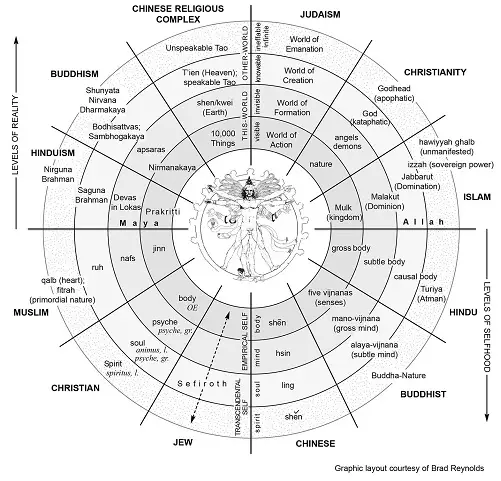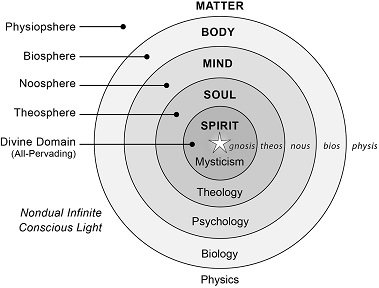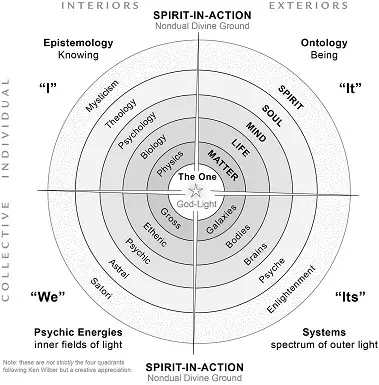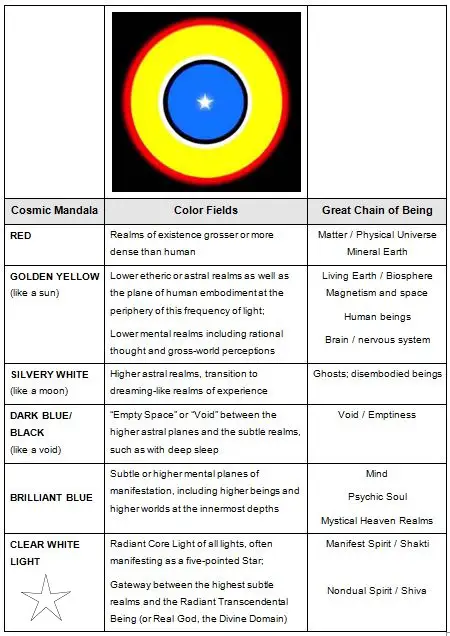|
TRANSLATE THIS ARTICLE
Integral World: Exploring Theories of Everything
An independent forum for a critical discussion of the integral philosophy of Ken Wilber
 Brad Reynolds did graduate work at the California Institute of Integral Studies (CIIS) before leaving to study under Ken Wilber for a decade, and published two books reviewing Wilber's work: Embracing Reality: The Integral Vision of Ken Wilber (Tarcher, 2004), Where's Wilber At?: Ken Wilber's Integral Vision in the New Millennium (Paragon House, 2006) and God's Great Tradition of Global Wisdom: Guru Yoga-Satsang in the Integral Age (Bright Alliance, 2021). Visit: http://integralartandstudies.com Brad Reynolds did graduate work at the California Institute of Integral Studies (CIIS) before leaving to study under Ken Wilber for a decade, and published two books reviewing Wilber's work: Embracing Reality: The Integral Vision of Ken Wilber (Tarcher, 2004), Where's Wilber At?: Ken Wilber's Integral Vision in the New Millennium (Paragon House, 2006) and God's Great Tradition of Global Wisdom: Guru Yoga-Satsang in the Integral Age (Bright Alliance, 2021). Visit: http://integralartandstudies.com
Seven Stages of LifeMapping Kosmos-ConsciousnessBrad Reynolds
[This is an excerpt from my forthcoming book Growing In God: Seven Stages of Life from Birth to Enlightenment — An Integral Interpretation by Brad Reynolds]
The “Seven Stages of Life” is Avatar Adi Da Samraj's developmental model for recognizing all the possible phases of human growth, from birth to adulthood, from yogic and mystical experiences to ego-death and Whole Body Enlightenment (which itself has several stages). This is a unique and groundbreaking “map” for a person to use in gathering a general understanding of his or her growth in both body and mind and soul and spirit. Importantly, it did not arise simply from studying and synthesizing scientific evidence, but has arisen from Adi Da's enlightened state of awareness, thus providing an invaluable perspective on human psychology and development. Fundamentally, the “Seven Stages” model is based on a deep understanding of the esoteric anatomy of the human body-mind complex. This means it includes all the major bodily regions and the inner core of the mind and heart, correlating with the chakras (or “wheels” of energy), and how they relate to the higher yogas of human spiritual evolution. This achievement alone makes it a nearly unparalleled advancement in understanding the depths of human psychology and the human potential, which should be widely used by lay people and professionals alike, if they take the time to learn about its advantages. It can serve us in advancing the development of our children, as well as facilitating the potential healing of distorted or malformed adulthood development. Its overall simplicity, as well as its profound accuracy and depth, is one of Adi Da's enlightened gifts to humanity, for it not only illuminates individual development but collective socio-cultural and religious evolution as well. Significantly, I have found these “seven stages” correspond accurately to the “basic structures” or “waves” documented in detail by Ken Wilber's Integral Psychology, which is based on an exhaustive integration of the experimental data of Western science (and the acquired knowledge of modern psychology) coupled with the experiential research of Eastern meditative disciplines revealing the timeless wisdom uncovered by the mystical traditions the world over. No small achievement, indeed. Importantly, Adi Da's Seven Stage model also includes states, types, and lines, and even “quadrants,” although it does not distinguish them in those terms. The Sat-Guru's version, in other words, is more holistic and integrated for the average person providing an easier and more accessible model for spiritual understanding (if not the more intricate details of psychological theories). Yet, this is also why supplementing it with Wilber's AQAL model provides an interesting integration, as I'll try to show. Therefore, in presenting Adi Da's developmental model, I will also confirm and buttress the Sat-Guru's “stages” with the “fulcrums” of development outlined by Wilber in his various books, for they both supplement and complement one another almost perfectly.[1] One approach is a comprehensive integration of the Western schools of psychology, from developmental ones to transpersonal modes, united with the spiritual wisdom of Eastern mysticism and advanced esoteric yogas. Yet, in this case, Wilber, as an integral pandit[2] or intellectual defender of the Dharma (or “Teaching of Truth”), has also teased apart their different structure-stages by diligently participating in their prescribed disciplines, thus providing him with enlightening disclosures that inform his books and integral ideas. The other view, however, is an enlightened (or God-Realized) exposition from a bona fide Spiritual Master, a genuine Guru whose sole function as an Agent of God is to Liberate others in Divine Enlightenment (or God-Realization). Importantly, this individual (born as Franklin Albert Jones) has also personally experienced for himself all the possible Seven Stages of Life, including most advanced kundalini and yogic transformations culminating in Nondual Enlightenment, the pinnacle of human development from whatever point of view. Since the Sat-Guru has not relied exclusively on science (nor does he reject it), his model is less complex than that of the integral pandit's, which is saturated with scientific evidence and philosophical concepts (and, some bemoan, too much jargon). However, I believe this is an advantage for Adi Da's model in many ways, especially for the average person, so instead of having more than two dozen levels and numerous lines, states, types, etc., (as Wilber's model does), it has only seven major stages that are fully capable of including (yet transcending) all the details that science and Integral Theory provides. In Adi Da's Seven Stages of Life model, the entire AQAL Matrix (of “all quadrants, all levels, all lines,” et al.) is fully implied and embraced, although all the details have not been specifically enumerated. This is, however, exactly one reason why both models work so very well together in order to give us a clearer picture of our present situation as human beings… and where the future may lead (for everyone follows the same developmental sequence wherever they are born). What is important, for most people, is how effective a model or map of the Seven Stages of Life is for each individual and the society at large. In either case, we're fortunate to have both of these excellent guideposts for charting our developmental journey from birth to Enlightenment, from infancy to God-Realization, from the fetus to death and beyond, from ignorance to wisdom. This is because a lack of such enlightened wisdom has been responsible for much of the world's problems and the ills of humanity, let alone the stagnation that occurs when people do not develop their full potential as an individual human being. Today, however, we can freely access this comprehensive map (if we learn its contours) to lead our children, our friends, our future, and ourselves to a brighter and more enlightened future. Therefore, I suggest, it's important to embrace both models (and men) in a complementary fashion, and receive the wisdom from both of these towering giants in intellectual and spiritual history. Yet, without both of them, our models may very well lack the completeness they need to be fully effective in serving the process of growth to (and in) God-Realization. The world simply needs the Sat-Guru and the Integral Pandit like never before! Kosmic Mandala: A Holarchy of Transcend-and-IncludeSince the developmental models of Adi Da Samraj and Ken Wilber provide an evolutionary map of human growth, one of the main reasons they work so well together is that each is based upon natural hierarchies found within the esoteric anatomy of the human body-mind situated within a multilayered cosmos. Both the cosmos and psyche are made up of the various structures and states of consciousness produced by the unfolding evolution of the universe, from the Big Bang to Divine Translation. Best described as a holarchy, for it's not a strict linear process, like the word hierarchy implies, for this map is one of embracing structures that “transcend and include” the previous ones. Such a mandalic model represents increasing levels (or depth) of conscious awareness as development proceeds. Wilber prefers to call this hierarchical organization of structures a “Kosmos,” using the ancient Greek word kös-mös to render an ordered and harmonious universe, whereas Adi Da calls our manifested existence a “Cosmic Mandala” (thus Wilber has used “Kosmic Mandala”), all of which work wonderfully well together in conveying the nested or hierarchical structure of existence. Indeed, our very consciousness itself reflects the multi-layered structure of the Kosmos, and even more so, because it includes the depths of interiors that leads to God-Realization or an understanding of Truth and Reality as it really IS. We do not live in a “flat” or merely physical material universe, in other words, but a psycho-physical reality composed of many levels or realms or structures of existence. Yet still, as the Sages teach, Reality as a whole is basically composed of the gross-physical universe, the subtle-mental interiors, and the causal-archetypal (or “root”) realms of existence. Everything can be classified into one of these schemes or realms of existence since they are simply different forms of energy, or Divine Energy. And, as Integral Philosophy points out, each stage and level (or holon) has interconnected correlates of interiors and exteriors (or all quadrants) all the way up and down the entire spectrum of Kosmos-Consciousness. Even the causal, for example, has a correlate in the right side of the heart, as both Wilber and Adi Da (and others) maintain. Best of all, everything that exists is arising as One Divine Consciousness, a fundamental condition of Love-Bliss and Pure Happiness. This is the real genuine “Theory of Everything,” as Wilber is attempting to show. In Reality, we discover, our universe or Kosmos is nothing but the transcendent Divine Spirit immanently alive as “Spirit-in-action,” as integral philosophers now maintain, giving us an Integral Vision grounded in the wisdom of Enlightenment. We live not only in an evolutionary universe, but a panentheistic (“all-in-God”) Kosmos, one where Spirit is immanent but also radically transcendent. This is a paradox beyond belief, thus it's only realizable as truth (beyond all subjective points of view). In the end, and right now, it's God Only, as the enlightened perspective has always maintained for millennia. Now our intellectual models have incorporated this nondual truth, thus possibly affecting the evolution of our future as a species. Or we can only hope. After all, they tell us, it's nothing but the relative play of Absolute Conscious Light, exactly as the scriptures have declared. But not everyone realizes this, of course, therefore we must continue evolving and growing and developing our understanding in consciousness. This is exactly why we need as precise maps as possible to help guide our way. Traditionally this pluridimensional view has been called a “Great Chain of Being,” but Wilber now sees it as a “Great Nest of Spirit,” for all the world's wisdom traditions have universally recognized some sort of multilayered, pluridimensional Reality in which we inhere. See Huston Smith's wonderful diagram, which I personally helped him to create graphically, showing the basic levels of Reality and of selfhood (of ontology and epistemology) as generally recognized by the world's Great Wisdom Traditions, or Philosophia perennis — the Perennial Philosophy. 
Huston Smith's Great Nest of World Religions — Philosophia perennis
In simple Western terms, the integral model of “transcend and include” is made up of matter, nature, body, mind, soul, and spirit with each higher level embracing all the lower ones yet “adding something more” — all arising within Nondual Divine Spirit. Wilber's unique contribution, of course, is making sure that an “AQAL” Mandala or Map contains at least all “four quadrants” (or the interiors and exteriors of both individuals and collectives) in order to be called a truly comprehensive and “integral” map. Wilber categorized these “basic levels” or spheres of the Kosmos into the physiosphere (matter), biosphere (nature, body), noosphere (mind), and theosphere (soul, spirit), with each “sphere” having their own corresponding fields of study, from physics to mysticism, from biology to theology, as graphically shown in the figure below:

Kosmic Mandala — Fields of Study
Importantly, both men, the Sat-Guru and the Pandit, welcome science as a valid partner, since each of the various forms of knowledge acquisition (i.e., the physical-biological, mental, spiritual) is addressing its own level of experiential data, while only the fully Enlightened View is truly (or ultimately) holistic and inclusive (a point of view that's also incorporated into Wilber's Integral Psychology). Nonetheless, both the Sat-Guru (Adi Da) and the Pandit (Wilber) are harsh critics of the reductionistic and scientific materialist worldview, which erroneously reduces all phenomena, from spirit to mind, to be nothing more than atoms and molecules banging about by chance or necessity. From the Enlightened perspective, however, which both men powerfully promote, the entire spectrum of existence is nothing but the play of Light, or Energy (Shakti), which is really nothing but, ultimately, the dance of Divine Conscious Light (or Consciousness Itself), also known as the “play” or “creation” of God.

Kosmic Mandala of Light
The important point is that the higher, more-inclusive spheres transcend-and-include the lower ones (from gross to subtle to causal to nondual God). Avatar Adi Da's “Cosmic Mandala” also has “rings” or “spheres” of vibrating energy sheaths manifesting as the realms of “broken” Indivisible Conscious Light, whereas Wilber's “Kosmic (or AQAL) Matrix” is floating-existing and “tetra-evolving” in the Nondual Divinity of Spirit-in-action, by whatever name you wish. Adi Da's “Cosmic Mandala,” however, unlike Wilber's, is not a synthesis of all previous models (put together with vision-logic), but arises from the Sat-Guru's enlightened insight and intuitive psychic revelations, the awakened wisdom of an Avatar that's been condensed into a working mandala for people to more easily understand. Mostly, in accord with the wisdom traditions of Advaita Vedanta and Buddhism, Adi Da also acknowledges that the gross, subtle, and casual realms are the fundamental divisions or realms of reality, yet are themselves transcended by Turiya (the nondual “fourth” state), the Divine “Witness,” and even Turiyatita, which Adi Da equates with “Conscious Light,” the “Indivisible Oneness of Unbroken Light” which is Consciousness Itself (Real God). The Siddha-Adept also calls this “the Heart,” beyond definition or location, unspeakable but Absolutely Real. A creative interpretation of Wilber's “four quadrants” seen as a Great Nest of Spirit-in-action could be pictured as below:

Kosmic Mandala or Great Nest of Spirit-In-Action
The depth and profundity of Avatar Adi Da's “Cosmic Mandala” or “Cosmic Sphere” is impossible to outline or explain in words alone (for a fuller explanation, please turn to The Dawn Horse Testament). Let it therefore be sufficient for our purposes to summarize these levels in the Table below: 
Adi Da Samraj's “Cosmic Mandala” or “Cosmic Sphere”
In harmonious appreciation of both models, I maintain that Adi Da's “Seven Stages of Life” model is fully AQAL-compliant, since it includes all levels, all lines, all types, et al. That is, the Seven Stages of Life includes (and transcends) the full spectrum of development and evolutionary growth in interiors and exteriors from individual holons (or “whole/parts”) to collective systems (thus contains all “four quadrants”), all arising within and as Divine Spirit, an unspeakable display of wonder and awe. Wilber's model is more specific and detailed, filling in the gaps, coloring in the rainbow, so to speak, while Adi Da's is more general, yet, still, I believe it's the most true and valid for it's the most enlightened. For us, they both work together in a grand and gracious harmony creating an illuminating “map” (which is not the territory) that describes our overall evolutionary history as a “Kosmos Story” in a new and divine light. Both explain, for example, that brain chemistry and chakras have their place, that atomic molecules and visions of gods and goddesses address their unique levels of existence, that mind is part of soul which is part of spirit, and that socio-cultural evolution mirrors the development of the human being, among other revealing insights. It's a breakthrough understanding worthy of everyone's diligent study and realization. Importantly, this developmental scheme of consciousness applies to the evolution of collective human cultures as well as to individual people who reside within their religious-social structures and worldviews. Or at least there are corresponding parallels close enough to warrant and garner useful insights verging on an unprecedented vision of wisdom. Science really does not contradict these views, although its language (and mindset) cannot fully confirm or comprehend them either, meaning that each perspective has its own form of valid knowledge to share and give. Our “story,” our “Universe Story” or “Kosmos Story,” the historical development of self and society within the universe as a whole, therefore includes insides and outsides, scientists and mystics, historians and sages, the immanent and transcendent, all as One Reality embraced in the prior unity of Real God. It doesn't get any better than this — the harmonious union of the Sat-Guru and the Pandit in an enlightened view of Kosmos and Consciousness! NOTES[1] See: Embracing Reality: The Integral Vision of Ken Wilber: A Historical Survey and Chapter-by-Chapter Guide to Wilber's Major Works (2004, New York: Tarcher/Penguin); Where's Wilber At? Ken Wilber's Integral Vision in the New Millennium (2006, St. Paul, MN: Paragon House); and Growing In God: Seven Stages of Life from Birth to Enlightenment—an Integral Interpretation (forthcoming) by Brad Reynolds. [2] “Pandit” is the Sanskrit root of the English word “pundit,” which means a learned person, or expert,” while formally a “pandit” in India goes further in harnessing the intellect (or mind) in service of Divine Realization and confirming the authenticity of sacred scriptures, which Wilber has notably done, thus he truly deserves the title even as a Westerner. See: The Sat-Guru and The Pandit: The Relationship of Two Spiritual Giants at the Dawn of the Third Millennium (unpublished) by Brad Reynolds.
|